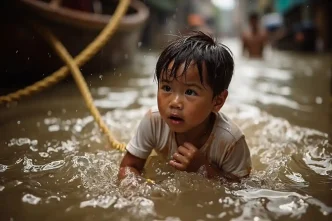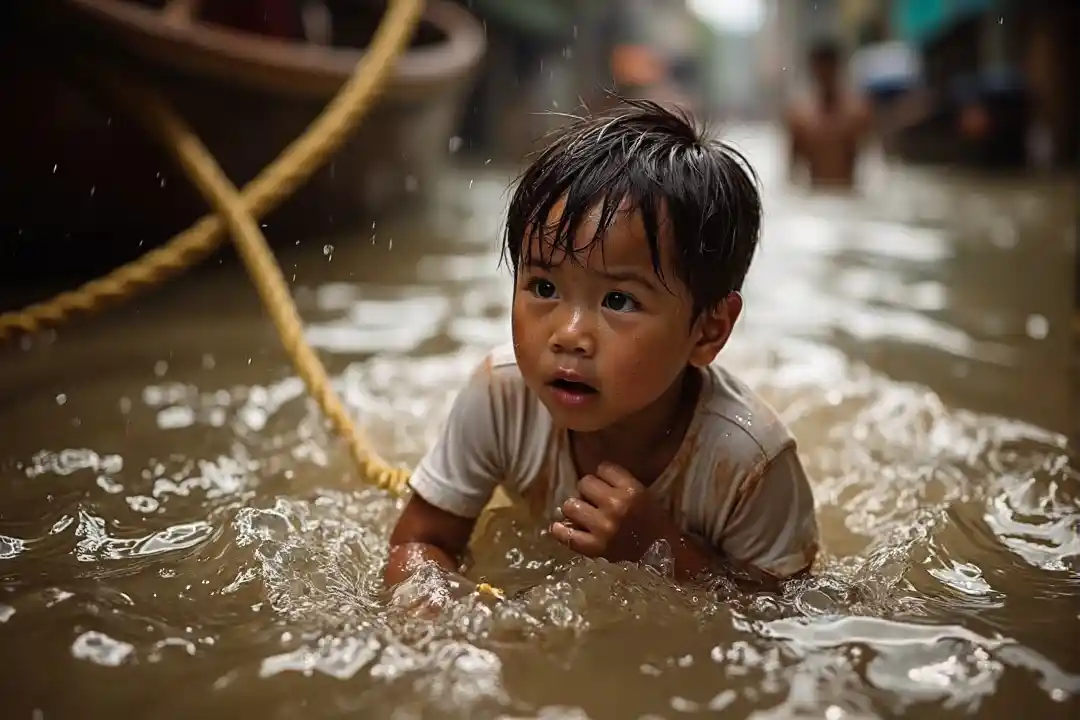In the Bangsamoro Autonomous Region of Muslim Mindanao (BARMM), a devastating combination of torrential rains and lingering political unrest has pushed flood-hit communities to the brink of a humanitarian crisis. Heavy downpours, driven by the intertropical convergence zone, have submerged vast areas of Maguindanao del Sur and Maguindanao del Norte, displacing over 266,000 individuals and exacerbating tensions in a region still reeling from recent violent elections. As floodwaters rise, aid efforts struggle to keep pace, while warnings mount of a potential escalation in insecurity if urgent action is not taken.
Scale of the Disaster
The flooding, which began intensifying over the past week, has affected 53,214 households across 140 villages in 14 towns of Maguindanao del Sur, with additional areas in Maguindanao del Norte also inundated. Joel Mamon, regional director of the Office of Civil Defense in BARMM, reported that the deluge has overwhelmed low-lying areas surrounding the Liguasan Marsh, a critical catchment basin for river water from South Cotabato and Sultan Kudarat. The marsh, which channels water into the Moro Gulf via the Rio Grande de Mindanao, has become a focal point of the crisis, with rising waters rendering traditional security measures ineffective.
Beyond Maguindanao, flash floods have struck Basilan and Sulu provinces, though the full extent of the damage there remains unclear. In Zamboanga del Sur, the Rebokon Agricultural and Vocational High School in Dumalinao town was submerged under three feet of water on Sunday, after debris blocked a nearby bridge, according to Joemar Suganob, head of the town’s Municipal Disaster Risk Reduction and Management Office. Meanwhile, in Sultan Kudarat province, tragedy struck as a mother, her daughter, and another child drowned in separate incidents on Friday.
Agricultural and Economic Fallout
The economic toll of the floods is staggering, particularly for a region heavily reliant on agriculture. In Datu Abdullah Sangki, a town in Maguindanao del Sur, authorities have reported crop losses across 1,552 hectares of farmland, with rice paddies, cornfields, and fishponds destroyed by the deluge. The destruction of livelihoods has left many families without a source of income, raising fears of long-term food insecurity. While the Bangsamoro government has begun distributing relief, officials acknowledge that the scale of the damage far exceeds current resources, with more assistance urgently needed.
The financial burden on affected communities is compounded by the region’s already fragile economic state. Many of the displaced lack the means to rebuild, and without immediate support, the risk of desperation driving individuals toward illicit activities grows. The cost of recovery, though not yet fully tallied, is expected to run into millions of Philippine Pesos, with local currency figures yet to be converted pending updated exchange rates for May 26, 2025.
Political and Security Risks
The flooding arrives at a particularly volatile moment for Bangsamoro, where the scars of recent elections—described by observers as the most violent in the region’s history—are still fresh. The Climate Conflict Action Asia (CCAA), a Mindanao-based monitoring group, has issued a stark warning about the potential for a “full-blown humanitarian crisis” if aid and recovery efforts are not prioritized. The group highlighted the intersection of environmental disaster and political conflict, noting that the inundation of Maguindanao del Sur has deepened “uncertainty and insecurity” in areas already grappling with a history of violence and the presence of armed groups.
“The convergence of political conflicts and its disaster-related impact demands urgent and coordinated action from local governments, the BARMM, and the national government to prevent a dangerous tipping point that would further destabilize an already volatile region” said a CCAA spokesperson. The organization has called for equitable distribution of aid, irrespective of political affiliations, to mitigate grievances stemming from the recent elections and prevent the rekindling of clan-based flashpoints.
Adding to the complexity, the flooding of Liguasan Marsh has created security vulnerabilities. With traditional checkpoints along main roads underwater, illicit groups are reportedly exploiting the situation to transport drugs, arms, and people by boat, bypassing security posts entirely. The CCAA cautioned that displaced individuals, facing economic hardship, may be lured into joining mercenary groups, paramilitary forces, or extremist organizations in exchange for payment, or may turn to the illegal drug trade as a means of survival.
Humanitarian Response and Challenges
Efforts to address the crisis are underway, but the scale of the disaster presents significant logistical hurdles. Mamon, alongside Col. Caezar Pascua, commander of the Tactical Operations Group, conducted an aerial survey of the affected areas on Saturday, identifying the towns surrounding Liguasan Marsh as the most severely impacted. While the Bangsamoro government has mobilized resources, the sheer number of displaced families—over a quarter of a million individuals—has strained capacity.
Humanitarian organizations and local authorities face additional challenges in ensuring that aid reaches all communities fairly. In a region marked by political divisions and clan rivalries, there is a risk that relief distribution could become a source of further tension if perceived as biased. The CCAA’s plea for impartial aid delivery underscores the delicate balance between addressing immediate needs and preventing long-term conflict.
Historical Context of Vulnerability
The flooding in Bangsamoro is not an isolated event but part of a recurring pattern of environmental and social challenges in the region. The Liguasan Marsh area, while a vital ecological zone, has long been a flashpoint for both natural disasters and human conflict. Its role as a catch basin means that heavy rains inevitably lead to overflows, impacting surrounding towns in Maguindanao and Cotabato provinces. Historically, these environmental pressures have intersected with socio-political issues, including disputes over land, resources, and political power.
The region’s history of armed conflict, including struggles between government forces, separatist groups, and private armies, adds another layer of complexity. While the establishment of BARMM in 2019 was intended to bring peace and autonomy to Muslim Mindanao, underlying tensions persist, often exacerbated by external shocks such as natural disasters. The recent elections, marred by violence, have only heightened these divisions, making the current crisis a test of the region’s fragile stability.
Broader Implications for Mindanao
The flooding in Bangsamoro is a microcosm of broader challenges facing Mindanao, where environmental degradation, poverty, and conflict often converge. Climate change has intensified weather patterns, with the intertropical convergence zone bringing heavier and more unpredictable rains to the region. This, in turn, amplifies the risk of displacement and economic loss, particularly for rural communities dependent on agriculture.
At the same time, the security implications of the crisis highlight the interconnectedness of environmental and political issues. The ability of illicit groups to exploit flooded areas for trafficking underscores the need for adaptive security measures, while the potential recruitment of displaced individuals into armed factions points to the urgency of addressing economic desperation. If left unaddressed, these dynamics could undermine years of peacebuilding efforts in Mindanao, with ripple effects across the southern Philippines.
Looking Ahead
As the floodwaters slowly recede, the true extent of the damage in Bangsamoro will come into sharper focus. For now, the priority remains delivering aid to those in need, rebuilding shattered livelihoods, and preventing the crisis from fueling further unrest. The coming weeks will test the capacity of local and national authorities to coordinate an effective response, as well as their commitment to ensuring that no community is left behind.
Yet, even as relief efforts ramp up, larger questions loom over the region’s future. How will Bangsamoro navigate the dual challenges of environmental vulnerability and political fragility? And can the current crisis serve as a catalyst for stronger cooperation between stakeholders, or will it deepen existing divides? For the hundreds of thousands displaced by the floods, the answers to these questions cannot come soon enough.
















